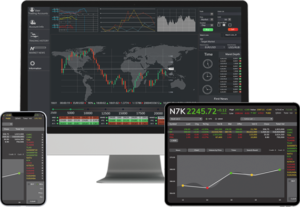AmerTD
How to trade
futures?
Unlocking the Potential of Futures Trading for Beginners and Experts
Futures trading offers a dynamic and potentially lucrative way to engage with various markets, from commodities and currencies to financial indices. By understanding the fundamental principles, selecting a reputable broker, and developing a solid trading plan, traders can navigate this complex landscape with confidence. Utilizing tools like demo accounts to gain experience and employing robust risk management strategies are crucial steps toward mitigating losses and maximizing profits. Continuous learning and adaptability are essential, as market conditions can change rapidly. With discipline and a strategic approach, futures trading can become a rewarding component of an investor’s portfolio.

-
Mastering Futures Trading
-
Futures Trading: Buying and selling contracts for assets to be delivered at a future date.
- Markets: Widely traded in commodities, currencies, and financial indices.
- Leverage: Futures allows significant leverage. Traders can control large positions with a relatively small capital.
- Futures Contract: An agreement to buy or sell an asset at a predetermined price at s specific time in the future.
- Margin: The amount of money required to open and maintain a future position.
-
Select a reputable broker with competitive fees and reliable platforms.
-
Select a Reputable Broker: Look for a broker with a good reputation, reliable trading platform, and reasonable fees.
-
Open an Account: Complete the necessary paperwork and deposit the required funds.
Outline your trading goals, strategies, and risk tolerance to stay disciplined and focused.
-
Define Your Strategy: Decide whether you will use technical analysis, fundamental analysis, or a combination of both.
-
Set Goals: Determine your financial goals and risk tolerance.
Create a clear roadmap outlining your trading goals, strategies, and risk management rules.
-
Use a Simulator: Many brokers offer demo accounts where you can practice trading without risking real money.
-
Gain Experience: Familiarize yourself with the trading platform and refine your strategy.
Basic Trading Strategies
Explore these fundamental strategies to help you navigate the futures market and maximize your trading potential.

Hedging
Use futures contracts to protect against price movements in the underlying asset. For example, a farmer might sell futures to lock in a price for their crops.

Speculation
Take positions based on your expectations of future price movements. If you believe prices will rise, you might buy futures; if you think they’ll fall, you might sell futures.

Spread Trading
Simultaneously buy and sell related futures contracts to profit from the price difference between them. This can involve different contract months or different but related commodities.

Arbitrage
Take advantage of price discrepancies between different markets. By buying futures contracts in one market and selling them in another where the price is higher, traders can lock in a risk-free profit.
Risk Management
Implementing effective risk management techniques is crucial for protecting your investments and ensuring long-term success in futures trading.

Set Stop-Loss Orders
Define the maximum loss you are willing to tolerate on a trade and set stop-loss orders accordingly.

Diversify Your Portfolio
Don’t put all your eggs in one basket. Spread your investments across different assets and markets.

Stay Informed
Keep up with market news, economic indicators, and other factors that can influence prices. Staying informed can help you make better trading decisions.

Monitor Your Positions Regularly
Frequently review your open positions to ensure they align with your trading plan and risk tolerance, and make adjustments as necessary.
Futures trading can be a powerful tool for hedging and speculation, offering opportunities for profit in various market conditions. By educating yourself, choosing the right broker, and developing a solid trading plan, you can navigate the futures market with confidence. Remember to manage your risks carefully and stay informed about market developments.
Happy trading!
![]()

